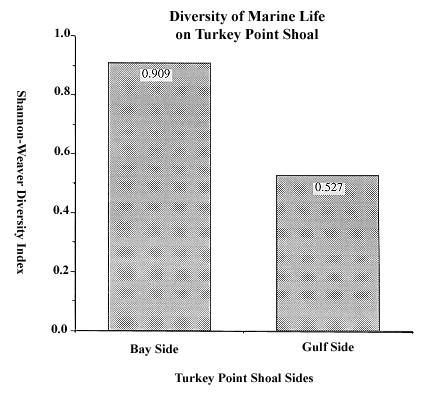



Jami Allred, Edward Baldwin, Daniel Barber,
Alicia Carpenter, Jeff Fischer, Emily McLarty,
Endia Macon, Mark Myrick, Kenny Rines, Ryan Solberger
On the first day we trawled and snorkeled at Turkey Point Shoal in St. George Sound, Gulf of Mexico. We observed many different types of marine species. We noticed different types of bottoms and wave energy in different areas. We observed a difference between the bay side of Turkey Point Shoal than the gulf side of Turkey Point Shoal. These initial observations led us to ask the question, "Is there more diversity of marine life in turtle grass inside the bay than outside in the gulf?" We came up with this question from the trawling and basic observations we did.
We hypothesized many things. First we hypothesized that we would have some similar species, as well as different species. Then we hypothesized that there would be more diversity on the bay side because higher wave energy on the gulf side might be harder to live in. There was more algae on the bay side which meant more food and protection for the marine life on that side.
This work was important to do because it helped us learn more about marine life. We observed many new things that we never knew about before which we can share with others. Now we have a better understanding of our environment, the different types of species, and their habitats.
The knowledge gained in this project may help other marine biologists and other scientists in their selection of field work and locations. It would also help fishermen in their search for good bait fishing areas.
Materials and Methods
Our research was performed at Turkey Point Shoal in the Gulf of Mexico near the Florida State University Marine Lab at Turkey Point. The area is a shallow clear and sandy area like a typical northeastern sand bar in the Gulf of Mexico.
The pontoon boats were provided by the FSU Marine Lab and were equipped with a sorting table, compass, 16 foot otter trawl net, and five gallon sorting buckets.
Our trawling was done on July 30, 1996, between 1330 and 1530 EDT. Two boats were used and each did four trawls - two on the bay side ( 29š 53.7'N, 84š 29.7'W) and two on the gulf side (29š 53.4'N, 84š 29.3'W) of the shoal. All of our trawls were done during high tide. The environmental conditions were recorded. They included cloud cover, wind speed and direction, water temperature, water depth, time of day, speed of the boat water clarity, length and direction of drag, and location in latitude and longitude. For our trawls, the cloud cover was 10-50%. The average wind speed was 5-10 knots from the southwest. The water temperature was 30-31 degrees Celsius. The water depth was kept between 1.5 and 2 meters. The speed of the boat was kept at 2100 RPM. The bottom was visible at all of our trawl sites. The trawls were done for two minutes in a mostly northeast or northwest direction.
After we got our catch onto the boat we put it on the sorting table, divided it into buckets for invertebrates and vertebrates, and then we counted it by number in each species.
Diversity of each trawl was determined by the Shannon Weaver Diversity Equation: H' = (NlogN- Sn1logn1)/N, where N = Total number of animals, n = Total number of individuals of a species, H' = Habitat diversity (the chance of one individual coming into contact with an individual of another species). Results
As we trawled the Gulf and Bay sides of Turkey Point Shoal we noticed many similarities and differences. We found similarities in the species in all the gulf and bay trawls. Some of the species were pinfish, shrimp, crabs, and we found little black snails. The snails were so abundant we could not count them so we did not use them in our study.
However, the differences are numerous compared to the similarities of the gulf and bay trawls. We also noticed the average number of invertebrates were higher on the bay side ( average of 11.3 invertebrates species pertrawl) compared to the gulf side (average of 6.3 invertebrates species per trawl). Striped burr fish (known locally as the blow fish) and grouper were found only on the gulf side. We observed that there was much more drift algae on the bay side.
We used the Shannon-Weaver Diversity Index (H') to calculate the diversity of the marine life on the gulf side and the bay side of the Turkey Point Shoal. As can be seen in the following graph, the diversity of marine life on Turkey Point Shoal is higher on the bay side (average H'=0.909) than on the gulf side (average H'=0.527). This difference is statistically significant. Discussion
Our original question was, "What is the Diversity of Marine Life in seagrass on the gulf side and bay side of Turkey Point Shoal?" To better approach this question we needed to define diversity. Diversity is the total number of species, the total number of individuals in each species, and how these numbers are distributed. This is the chance, or probability, of one individual coming into contact with an individual of another species.
The results of our research clearly showed that the diversity of marine life at Turkey Point Shoal was higher on the bay side than the gulf side. There were a number of reasons we believe this is true. Wave energy was substantially stronger on the gulf side. This creates harsher conditions which some animals are better equipped for. This is reflected in the higher percentage of invertebrates that were found on the bay side. The algae content seemed to be greater on the bay side. We believe this is from the prominent wave energy on the gulf side, which forced the algae to settle on the bay side. The higher number of animals on the bay side could be related to the food and protection provided from the algae.
To further research this topic we could examine other variables which might affect the results. The season in which the data is collected could provide different species or number of individuals in each species. Factors of more or less algae are seasons and wave energy, which could vary your findings. Tidal currents are also a variable to be considered. We collected our data during the day, but collecting data at night might also provide different results. Finally, continuing this study over a span of years would provide much information and lead to further discovery.
